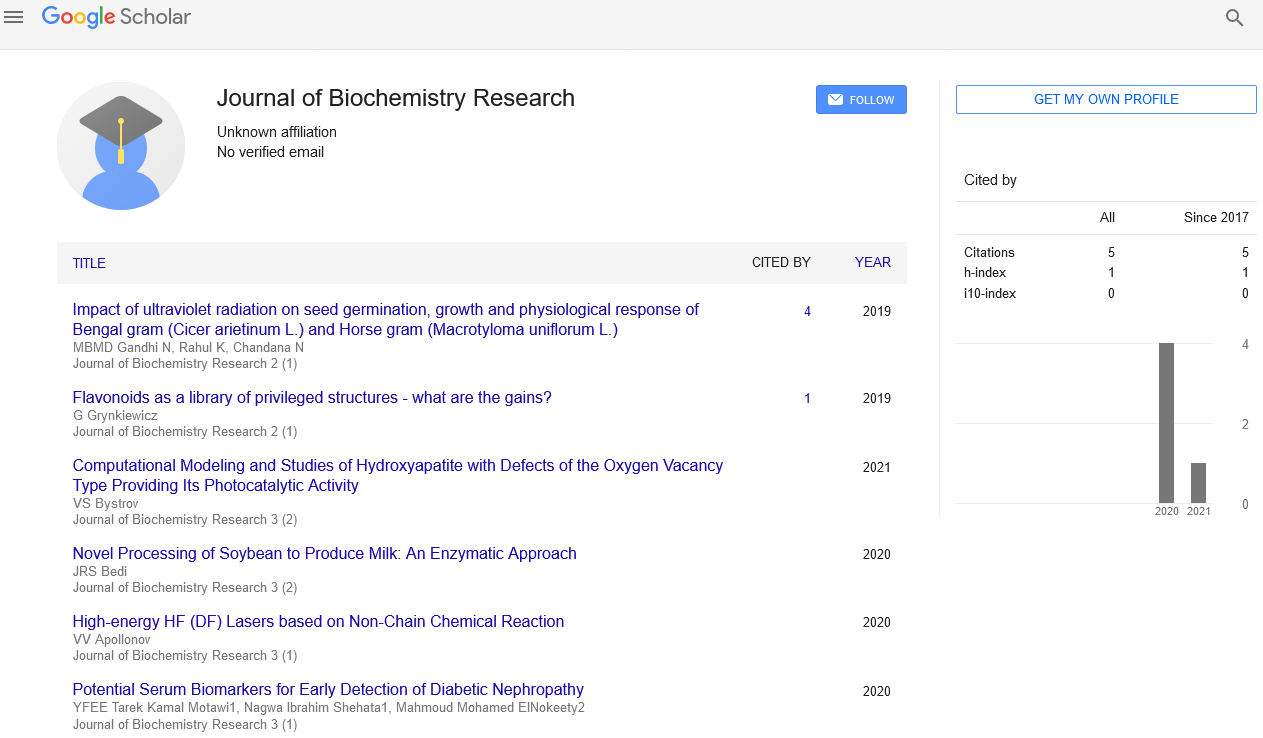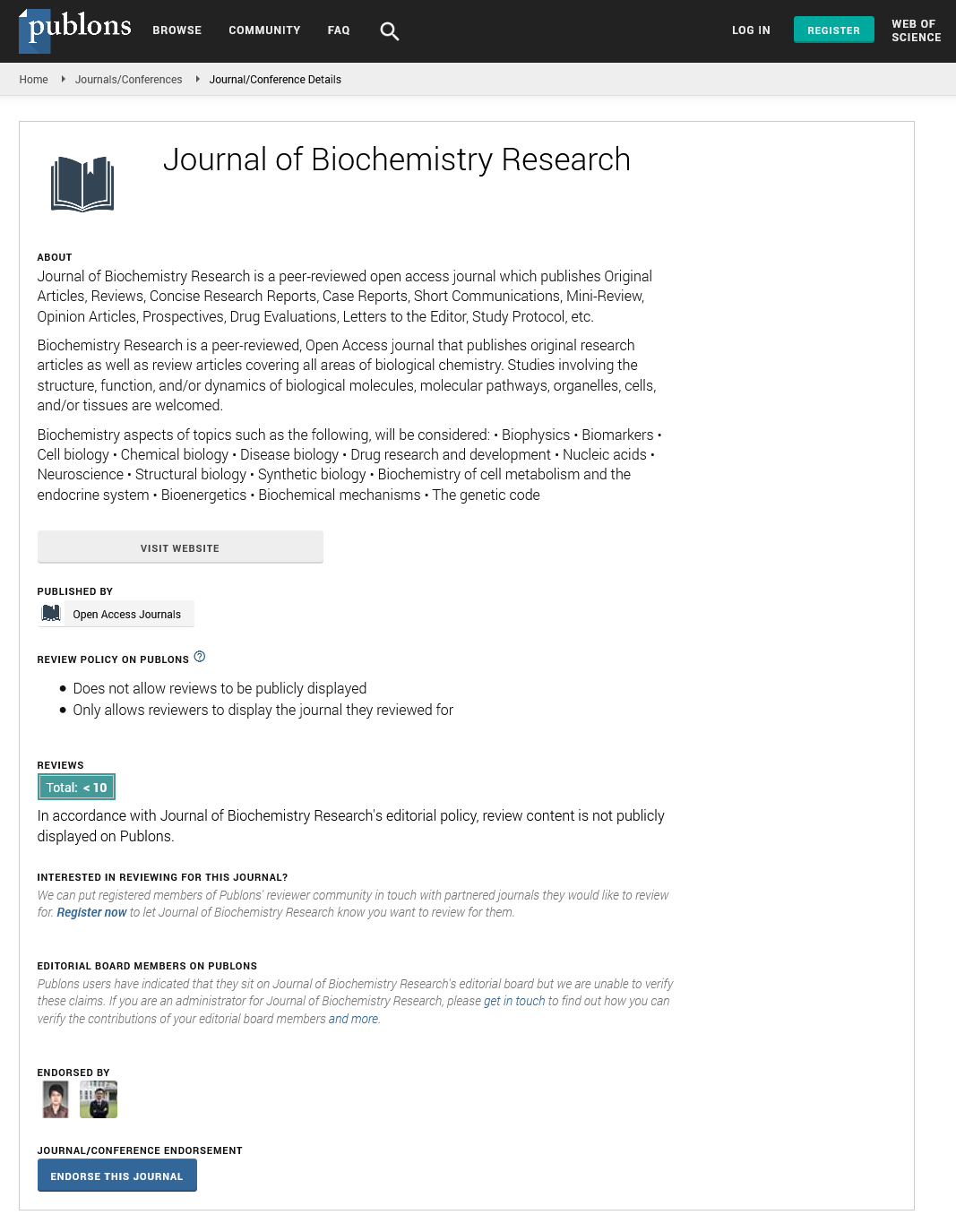Editorial - Journal of Biochemistry Research (2023) Volume 6, Issue 3
A Mini Review On Decoding the Genetic Code: Unveiling the Secrets of Life's Blueprint
Kabir Mao*
Department of Computer Science and Engineering, University of Ha’il, Australia
- *Corresponding Author:
- Kabir Mao*
Department of Computer Science and Engineering, University of Ha’il, Australia
E-mail: kabirm@gmail.co.in.edu
Received: 02-06-2023, Manuscript No. oabr-23-101541; Editor assigned: 05-06-2023, Pre QC No. oabr-23- 101541; Reviewed:19-06-2023, QC No. oabr-23-101541; Revised: 23-06- 2023, Manuscript No. oabr-23-101541 (R); Published: 30-06-2023; DOI: 10.37532/oabr.2023.6(3).70-72
Abstract
The genetic code is a fundamental aspect of life that holds the key to understanding the characteristics and functioning of all living organisms. This article explores the discovery, structure, and significance of the genetic code in unraveling the mysteries of life itself. It discusses the historical background and scientific breakthroughs that led to the identification of the genetic code, its structure as a triplet code, and the process of translation during protein synthesis. The article also highlights variations in the genetic code, its role in genetic disorders and diseases, the emerging field of synthetic biology, and the ethical considerations associated with manipulating the genetic code. The study of the genetic code continues to advance our understanding of genetics, evolution, and human health, presenting both opportunities and challenges for the future. The genetic code is the fundamental instruction manual of life, governing the characteristics and functions of all living organisms. This article delves into the exploration of the genetic code, unveiling its discovery, structure, and profound significance in unraveling the mysteries of life. Through an examination of historical milestones, it discusses the identification of the genetic code, which operates as a triplet code composed of codons encoding specific amino acids or signaling sequences. The translation process during protein synthesis is elucidated, involving messenger RNA (mRNA), transfer RNA (tRNA), and ribosomes. The existence of genetic code variations is explored, shedding light on the diversity of life’s blueprint. Understanding the genetic code’s function is crucial in comprehending genetic disorders and diseases, with mutations having profound implications. Moreover, the emerging field of synthetic biology and genetic engineering offers opportunities to manipulate the genetic code, raising ethical considerations.
Keywords
Genetic code • DNA • RNA • Codons • Protein synthesis • Translation • Triplet code • Variations • Genetic disorders • Synthetic biology • Ethics
Introduction
The genetic code is the fundamental instruction manual of life, a complex system that determines the characteristics and functioning of all living organisms. It holds the secrets to our physical traits, susceptibility to diseases, and even our behaviors [1]. Understanding the genetic code is akin to deciphering the blueprint of life itself, unraveling the intricate mechanisms that make us who we are [2]. In this article, we embark on a journey into the fascinating world of the genetic code, exploring its discovery, structure, and the profound significance it holds in our quest to unravel the mysteries of life [3]. The exploration of the genetic code began in the mid-20th century, as scientists delved into the realm of genetics, seeking to understand how genetic information is stored, transmitted, and ultimately expressed in living organisms [4]. One monumental milestone in this journey was the discovery of the double helix structure of DNA by James Watson and Francis Crick in 1953 [5]. This groundbreaking revelation laid the foundation for understanding the storage and replication of genetic information. Building upon the discovery of DNA’s structure, researchers soon turned their attention to uncovering the mechanisms by which DNA instructs the production of proteins, the workhorses of life [6]. It was during these investigations that the existence of the genetic code came to light [7]. Through diligent experimentation and ingenious insights, scientists unveiled the remarkable nature of the genetic code and its role in protein synthesis. At its core, the genetic code is composed of nucleotide sequences, the building blocks of DNA and its molecular cousin, RNA[8]. This code operates on a triplet structure, with each three-nucleotide sequence, known as a codon, encoding for a specific amino acid or serving as a signal to start or stop protein synthesis. With a total of 64 possible codons, the genetic code encompasses a comprehensive set of instructions that determine the sequence and composition of proteins in every living organism. The translation of the genetic code occurs during protein synthesis, a highly orchestrated process involving multiple players [9]. Messenger RNA (mRNA) serves as the intermediary between the DNA code and the protein-building machinery. Transfer RNA (tRNA) molecules, each specialized for a specific amino acid, read the mRNA codons and deliver the corresponding amino acids to the growing protein chain. This intricate dance of molecules ensures the accurate assembly of proteins, essential for the functioning of cells and organisms [10]. While the genetic code is largely universal across most organisms, there exist certain variations and exceptions. For instance, mitochondria, the energy-generating powerhouses within cells, possess their own distinct genetic code. Some microorganisms also exhibit unique genetic codes. Understanding these variations sheds light on the evolutionary history and diversity of life on Earth.
Materials and Methods
Genetic code database: To conduct research on the genetic code, various databases and online resources were utilized. These included the National Center for Biotechnology Information (NCBI) database, the Universal Protein Resource (UniProt), and other publicly available repositories of genetic information. These databases provided access to genetic sequences, codon tables, and related information necessary for understanding the genetic code.
Organization and structure: The gathered information was organized and structured to present a logical flow of concepts and ideas. The article was divided into sections covering the introduction, historical background, structure of the genetic code, translation process, genetic code variations, its role in genetic disorders and diseases, synthetic biology applications, and future directions. The sections were further divided into subsections to ensure clarity and coherence.
Structure of the genetic code: The genetic code is composed of nucleotide sequences, which are the building blocks of DNA and RNA. It is a triplet code, meaning that three nucleotides, called codons, encode for a specific amino acid or a signaling sequence. There are a total of 64 codons, with each codon representing a specific amino acid or serving as a stop signal for protein synthesis. This redundancy in the genetic code ensures the robustness and accuracy of protein production, allowing for the adaptation and evolution of organisms.Translation of the genetic code: The translation of the genetic code occurs during protein synthesis, a complex process involving ribosomes, transfer RNA (tRNA), and messenger RNA (mRNA). During translation, the mRNA molecule carries the genetic information from the DNA to the ribosome, where tRNA molecules recognize and bind to specific codons, delivering the corresponding amino acid. This sequential process continues until a complete protein is synthesized.
Genetic code variations: While the genetic code is universal across most organisms, there are certain variations and exceptions. These variations can be observed in mitochondria, the energy-producing organelles within cells, and in some microorganisms. Additionally, recent studies have revealed variations in the genetic code among certain species, expanding our understanding of the complexity of life’s blueprint.
Conclusion
The genetic code serves as the cornerstone of life, holding the key to understanding the characteristics, functions, and diversity of living organisms. Throughout this article, we have explored the discovery, structure, and significance of the genetic code, shedding light on the intricacies of life’s blueprint. The journey of decoding the genetic code began with the elucidation of DNA’s double helix structure by Watson and Crick, which provided the foundation for understanding genetic information storage and replication. Subsequent research efforts uncovered the existence of the genetic code, a triplet code composed of codons that encode for specific amino acids or serve as signals for protein synthesis. The translation process, involving mRNA, tRNA, and ribosomes, orchestrates the decoding of the genetic code during protein synthesis. This intricate molecular dance ensures the accurate assembly of proteins, which are essential for the proper functioning of cells and organisms. While the genetic code is largely universal, certain variations and exceptions exist, such as in mitochondria and some microorganisms. Studying these variations offers insights into the evolutionary history and diversity of life on Earth.
References
- Kobayashi H. Airway biofilms: implications for pathogenesis and therapy of respiratory tract infections. Respiratory medicine 4, 241-253 (2005).
- Jones G, Steketee RW, Black RE et al. How many child deaths can we prevent this year? Lancet. 362, 65-71 (2003).
- Roberts CK, Won D, PruthiS et al. Effect of a short-term diet and exercise intervention on oxidative stress, inflammation, MMP-9, and monocyte chemotactic activity in men with metabolic syndrome factors. J Appl Physiol. 100, 1657-65 (2006).
- Brand-Miller J, Foster-Powell K, Nutr M et al. Diets with a low glycemic index: from theory to practice. Nutrition Today. 34,64-72 (1999).
- Fogel DB. Factors associated with clinical trials that fail and opportunities for improving the likelihood of success: A review. Contemp Clin Trials Commun.11, 156-164 (2018).
- Prasad V, Mailankody S .Research and Development Spending to Bring a Single Cancer Drug to Market and Revenues After Approval. JAMA Intern Med. 177, 1569-1575(2017).
- Ananthakrishnan R, Ehrlicher A.The forces behind cell movement. Int J Biol Sci.3, 303-317(2007).
- Michie KA, Löwe J.Dynamic filaments of the bacterial cytoskeleton. Annu Rev Biochem.75, 467-492(2006).
- Headey DD, Chiu A, Kadiyala S. Agriculture's role in the Indian enigma: help or hindrance to the crisis of undernutrition? Food security. 4, 87-102 (2012).
- Maglaveras N, Stamkopoulos T, Diamantaras K et al. ECG pattern recognition and classification using non-linear transformations and neural networks: a review. Int J Med Inform. 52,191-208 (1998).
Indexed at, Google Scholar, Crossref
Indexed at, Google Scholar, Crossref
Indexed at, Google Scholar, Crossref
Indexed at, Google Scholar, Crossref
Indexed at, Google Scholar, Crossref
Indexed at, Google Scholar, Crossref
Indexed at, Google Scholar, Crossref
Indexed at, Google Scholar, Crossref
Indexed at, Google Scholar, Crossref


